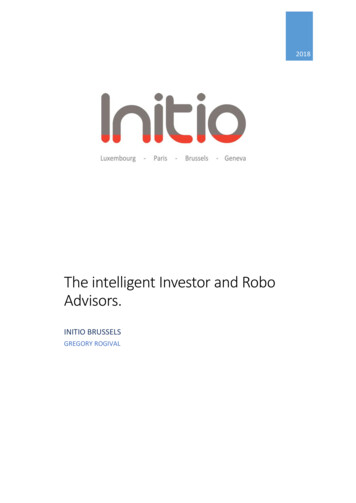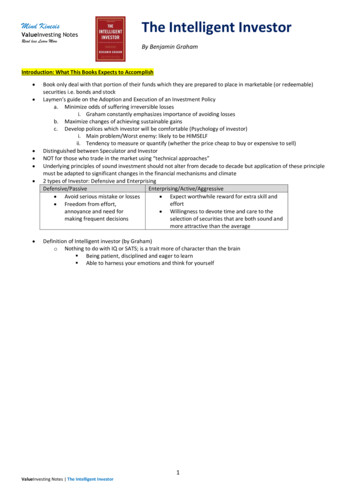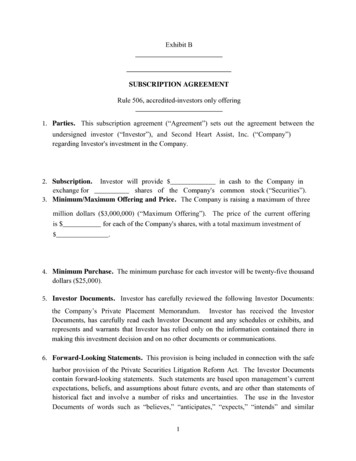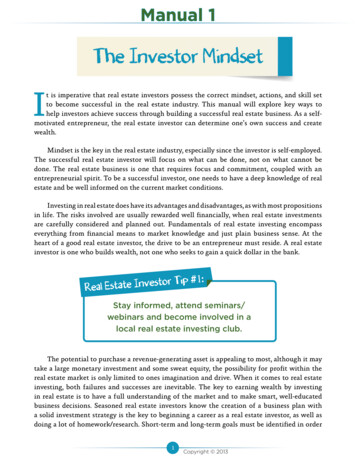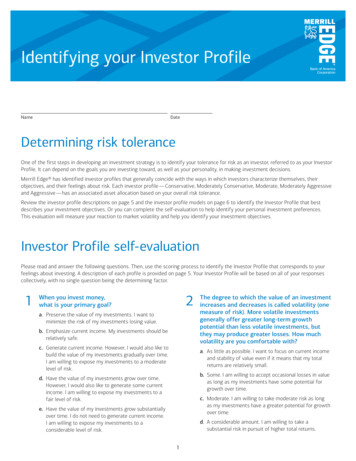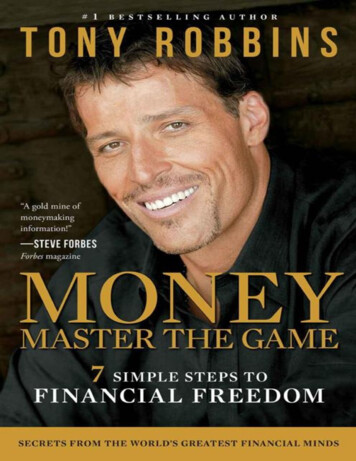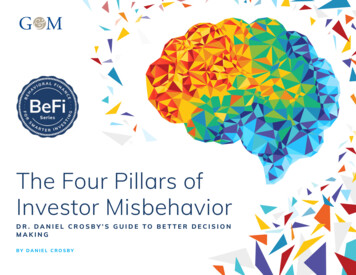
Transcription
The Four Pillars ofInvestor MisbehaviorDR. DANIEL CROSBY ’S GUIDE TO BETTER DECISIONMAKINGBY DANIEL CROSBY
About the AuthorDaniel Crosby is the Chief Behavioral Officer at Brinker CapitalInvestments. In this role, he is responsible for bringing behavioraltools, training, and technology to financial advisors to allow for thepractical application of behavioral science. He is a psychologistand behavioral finance expert who applies his study of marketpsychology to everything from financial production design to advisorclient engagement. Daniel has more than 10 years of experiencein the financial services industry and has published a number ofbestselling books that serve as guides to building stronger advisorclient engagement with a focus on achieving better outcomes.
IntroductionAs a child I loved reading Rudyard Kipling’s Just So Stories, a collection oftales originally crafted as bedtime stories for his daughter who demandedthat they be told “just so” (using the same words she was accustomed to).Each story provides a magical take on evolutionary biology and describeshow various animals acquired their most distinctive features.The flaws in your design quite naturally lead to quirks in your behavior,and creating a system that accounts for these quirks is a foundationalelement of any sound investment philosophy. Just as good defense winschampionships but the quarterback gets the endorsement deal, riskmanagement drives performance but big returns get all of the press.In How the Whale Got His Throat, we learn that whales can eatonly plankton as a result of one having swallowed a mariner, whosubsequently tied a raft inside its throat to prevent others from meetinghis fate.And so before we answer the question, “How can I become a skilledinvestor?” we must first answer the less-sexy-but-more-importantquestion, “How can I not suck at investing?” Put more gently, we mustlearn to manage risk. If you accept this as fact and pick up a textbookon risk management, you are likely to read about two primary types ofinvestment risk: systematic and unsystematic.In How the Camel Got His Hump, we learn that the dromedary’s hump is aresult of being lazy and subsequently cursed by a genie with a hump thatallows for greater work between periods of rest. In each case, the animalendures some hardship, but is ultimately rewarded with a distinctivefeature that is evolutionarily adaptive. Just like the stories themselves, theanimals are created “just so.”It is satisfying to think of a world where nature conspires to work inour favor, but that is sadly not reflective of our reality when it comes tofinancial decision-making. Your body and brain were created to do a greatmany things with remarkable efficiency; investing is not one of them. Infact, if a demigod, evil genie, or vengeful mariner set out to design theworst investor possible, they would have designed you.When it comes to investing, you were not created “just so.”Systematic risk, also known as “market risk,” is the chance that youwill lose money as a result of moves in the broad market as opposed tofactors relating to any business in particular.Unsystematic risk, also referred to as “business risk,” is the chance that aninvestment in an individual security will depreciate in value due to factorspertaining to that business.What your textbook will likely omit altogether is a third type of risk—behavioral risk—and this is the most important risk of all. Once weembrace the reality of behavioral risk, we must work to codify it and giveit form. After all, how can you fight a monster that you can’t see?
Decoding Behavioral RiskSo, how do we begin to give shape to something as amorphousas human behavior? As it turns out, you begin by studyinghow it malfunctions. As Daniel Kahneman says in The UndoingProject, “How do you understand memory? You don’t studymemory. You study forgetting.”Misbehaving, Richard Thaler’s incredible origin story of the field ofbehavioral economics, recounts the simple but effective way that heset the discipline on its current course. Incredulous about what he waslearning about efficient markets, Thaler set out to brainstorm all of thereal-life ways in which the people he knew differed from the “Econs”(fictional individuals who optimize utility and always make rationalfinancial decisions) he was learning about in his theory courses. Usingnothing more than a simple thought experiment, Thaler created a list ofbehavioral anomalies that launched a thousand research projects andvastly deepened our understanding of how mere mortals make financialdecisions.While the discovery and documentation of these behavioral anomalieswas an important first step, they lack utility to investors inasmuch as thereis no broader organizing framework. We now have long lists of the waysin which we are imperfect, but little in the way of practical next steps.As research has shown, bad news without a concrete solution set canactually exacerbate the problem!Inspired by the simple elegance of Thaler’s approach, I put on mycatastrophic thinking cap and set out to brainstorm every possible waysomeone’s behavior could negatively impact investment decision-making,relying heavily on the existing literature. I found over 117 different biasesand heuristics that could lead an aspiring investor from making optimaldecisions! Ouch. To make this universe more useful to investors, I lookedfor common psychological underpinnings among the various modes oferrorand grouped them accordingly. I began this process without preconceptionsof how the information would shake out. At the end, four consistent types ofbehavioral risk emerged, they are:EGOEMOTIONATTENTIONCONSERVATIONThe number of bad decisions we can make is nearly limitless (have youseen reality TV?), but all behavioral risk has one or more of these four riskfactors at its core. I’ll discuss each of them briefly below, with more detailedcoverage to come in the weeks to follow.
Ego RiskEgo risk is made manifest in behaviors that privilege our need for feltpersonal competency at the expense of clear-eyed decision making.Specific examples might include good old-fashioned overconfidence, atendency to become defensive when pet ideas are challenged (backfireeffect), or a belief that one’s mere involvement in a project makes it morelikely to succeed (the awesomely named IKEA effect).Ego risk leaves specific evidence of its presence in overly concentratedpositions, churning, failing to plan or work with a professional, and the useof excessive leverage. Whatever the specific manifestation, the source isalways the same—an ego that privileges its own care and feeding overmaking good decisions.EXAMPLES OF EGO RISK Choice Supportive Bias: The tendency to ascribe positive attributesto a chosen investment decision and denigrate the road not taken. Overconfidence: Felt competence or knowledge that exceeds actualcompetence or knowledge. Confirmation Bias: The propensity to seek out informationthat confirms an investment thesis and ignore disconfirmatoryinformation. Endowment Effect: The tendency to perceive a stock as valuablesimply because we own it. Semmelweis Reflex: The reflexive rejection of information thatdisagrees with a cherished idea or opinion. Illusion of Control: Proneness to believe we are more in charge ofmarket outcomes than we truly are. False Consensus: Overestimating the degree to which others agreewith our investment ideas.
Emotion RiskEmotion risk stems from the fact that our perceptions of risk are coloredby both our transitory emotional states and our individual propensitytoward positivity or negativity. Emotion leads most of us to underratethe possibility of bad things happening to us (optimism bias), to avoideven thinking about what might go wrong (ostrich effect), and to ignorethe important role emotion plays in our decisions (empathy gap). Whenfear does break through, it can become so powerful that we can beimmobilized by trying to avoid pain (negativity bias).Investors looking for examples of emotion bias in their decision-makingshould begin with periods of market turbulence. Examine trades for risktaking or safety seeking during periods of elevated sentiment. Also, lookfor herd following (fearful when others are fearful) versus appropriatecontrarianism (greedy when others are fearful) at historical market topsand bottoms.Research has shown that emotion plays an important role in facilitatingchoice. In fact, people with damage to the parts of their brain that processemotion are rendered unable to make even everyday decisions, suchas what to wear. The key is not to be free of emotion altogether, butto understand our personal susceptibilities to stress, panic and fear ofmissing out.EXAMPLES OF EMOTION RISK Affect Heuristic: The tendency for current emotional state to colorrisk perception. Empathy Gap: Underestimating our reliance on emotion andoverestimating our use of logic when making decisions. Negativity Effect: Bias toward negative events and thoughtsimpacting our risk-perception much more powerfully than positiveevents. Optimism Bias: Mistaken belief that we are less likely to experience anegative event than others. Ostrich Effect: Attempting to avoid risk by pretending it does notexist. Risk Compensation: Tendency to adjust risk-taking behavior relativeto subjective experience of risk (accounts for drivers going fasterwhen wearing a seat belt). Restraint Bias: Fallacious belief in our ability to control our ownimpulses in the face of intense emotion.
Attention RiskAttention risk is born of our disposition to evaluate information in relativeterms and let salience trump probability when making investmentdecisions. “Salience” is the psychological term for prominence, meaningthat our attention can be hijacked by low-probability-high-scarinessthings like shark attacks while ignoring high-probability-low-scarinessdangers like eating at Taco Bell. We also tend to rate the unfamiliar asmore risky and show a preference for domestic stocks (home bias) andfamiliar names (mere exposure effect), regardless of their fundamentalqualities.E X A M P L E S O F AT T E N T I O N R I S KThose looking for concrete evidence of attention risk in their investingshould be on the lookout for crowded trades, overreliance on domesticstocks, excessive correlation and high-noise-low-probability investmentsbased on a collective moment of panic (e.g., the Ebola scare). Dr. BobNease suggests that of the ten million bits of information our brainsprocess each second, a mere 50 bits are allotted to conscious thought!When so much of what pulls our thoughts and actions happens belowthe surface, we must be very intentional with how we spend the littleattention that is within our power. Home Bias: Bias toward viewing domestic equities as more safe andknowable than their international counterparts. Anchoring: Penchant for relying too heavily on the first piece ofinformation (e.g., price paid for a stock) when making investmentdecisions. Availability Bias: Confusing the ease of recalling information with itsimpact or probability. Attention Bias: Proneness to confuse our own rumination on asubject with its actual importance. Framing Effect: The tendency for our perception of risk to varydepending on whether it is framed as a loss or a gain. Mere Exposure Effect: Phenomenon by which we view stocks as lessrisky if we are familiar with the company.
Conservation RiskConservation risk is a by-product of our asymmetrical preference forgain relative to loss and the status quo relative to change. We likewinning much more than losing and the old way much better than thenew way, all of which contorts our ability to see the world clearly. Thisconservation effect can be observed in our resistance to new ways ofbeing (status quo bias), our preference for no risk at all relative to largeincremental decreases in risk (zero risk bias) and an aptness to privilegeour current self over the needs of our future self (hyperbolic discounting).Evidence of selling winning stocks too quickly and holding losing stockstoo long, a failure to maintain appropriate risk levels when “up” andsigns of taking excessive risks when “down” are all good signs that youmight have fallen prey to conservation risk. Our aversion to change andloss are primal and can only be unseated by a deliberate process aimedat recognizing and overcoming our behavioral inertia.E X A M P L E S O F C O N S E R VAT I O N R I S K Loss Aversion: The asymmetrical relationship between gain and loss,whereby the pain of a loss is much greater than the high of a gain. Status Quo Bias: Human preference for things to remain as they are. Sunk Cost Fallacy: Reasoning that further risk must be taken in anattempt to recoup past losses. Normalcy Bias: The belief that all that has been is all that will everbe. Zero Risk Bias: Preference for the total elimination of specific risks,even when alternative choices offer a greater overall reduction inrisk. Disposition Effect: Behavioral tendency to sell stocks that haveappreciated and to hold stocks that have fallen in value. Hyperbolic Discounting: Tendency to dramatically discount rewardsthat occur in the future relative to those occurring in the present.
This four-part framework serves as the intellectual scaffoldingupon which much of your behavioral finance work can be built.A qualified financial advisor—experienced in investing tools,training and technologies, and able to apply that experiencethrough a behavioral finance lens—can help you identify andovercome these all too common behavioral risk factors and setyourself on a path toward better investment outcomes.
180 Mt. Airy Rd., Suite 203Basking Ridge, ccarthy.comContact us todayto find out howwe can help youavoid commonbehavioral riskmistakes, and stayon track towardmeeting 211
fear does break through, it can become so powerful that we can be immobilized by trying to avoid pain (negativity bias). Investors looking for examples of emotion bias in their decision-making should begin with periods of market turbulence. Examine trades for risk taking or safety seeking during periods of elevated sentiment. Also, look


